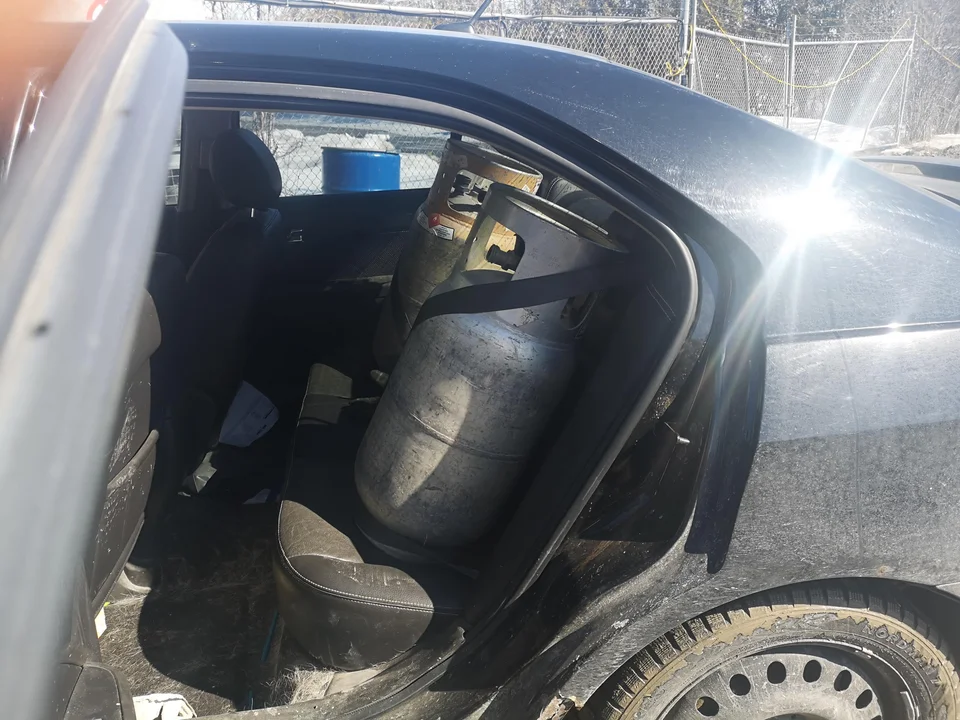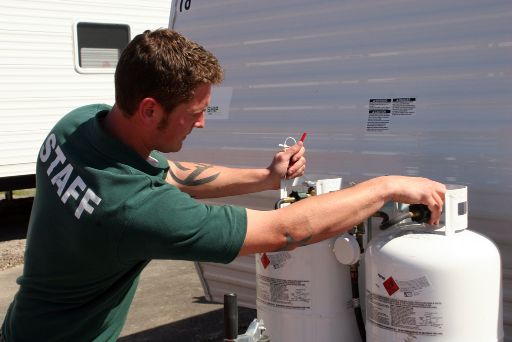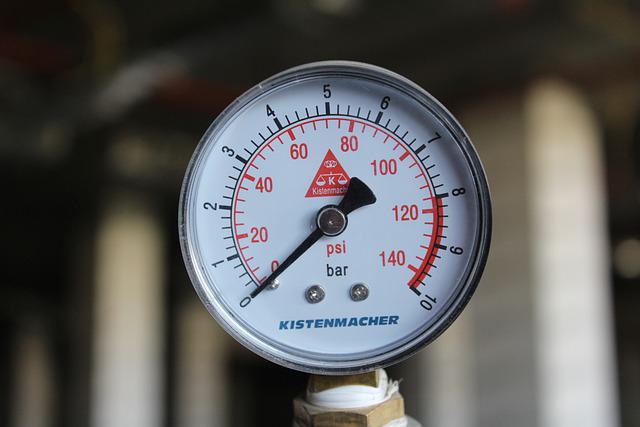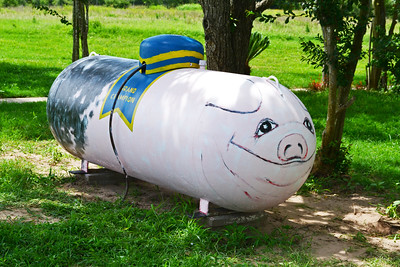
If you’re like most people, you probably think it’s okay to leave a propane tank in a hot car. After all, propane is a gas, and gases expand in heat. However, this is not the case with propane tanks. In fact, leaving a propane tank in a hot car can be extremely dangerous.
No, it’s not safe to leave a propane tank in a hot car. Rising temperatures can cause the propane inside the tank to expand, leading to increased pressure. This could cause the tank’s safety valve to release flammable gas, or in extreme cases, the tank could rupture or explode. Always transport propane tanks in a well-ventilated, cool space and never leave them unattended in a car.
Dangers of Leaving a Propane Tank in Your Car
A. The Pressure Factor in Your Propane Tank
- How Heat Affects Your Tank: When you leave a propane tank in your car, the heat causes the propane inside to expand, significantly increasing the pressure within the tank.
- Your Tank’s Safety Features: Your propane tank comes with a safety relief valve, which may release propane into your car if the internal pressure gets too high—a situation you certainly want to avoid.
- Wear and Tear: Frequent heating can strain your tank’s material, potentially leading to leaks or structural failures over time.
B. The Leakage and Gas Expansion Hazard
- The Real Risk of Leaks: As pressure builds, you might not notice a minor leak, but in the enclosed space of your car, it could have major consequences.
- Why Ventilation Matters: Your car isn’t designed to handle the escape of hazardous gases like propane, lacking the proper ventilation to ensure your safety.
- The Danger of Asphyxiation: While propane isn’t toxic, it can lower the oxygen levels in your car, leading to a dangerous asphyxiation risk.
C. The Explosive Potential in Your Vehicle
- Propane’s Flammable Nature: You need to be aware that propane is highly flammable and, if mixed with the air in your car, a spark could set off an explosion.
- Everyday Ignition Sources: The everyday electrical systems and batteries in your car are potential ignition sources that could trigger a disaster.
- The Severity of an Explosion: An explosion could have devastating consequences, including severe injury or even death, not to mention the destruction of your car and surrounding property.
D. Legal and Insurance Consequences for You
- Staying on the Right Side of the Law: You’re expected to transport propane tanks in adherence to specific laws; failing to do so could see you facing fines or legal repercussions.
- Your Insurance May Not Cover You: If an accident occurs because you improperly transported a propane tank, your insurance might refuse to cover the damages due to your negligence.
- The Liability You Carry: Should your propane tank cause damage or injury, you could be held personally responsible for those damages, which is a financial and legal burden you don’t want to bear.
By understanding these risks, you can make informed decisions about transporting propane safely. Always prioritize safety and follow guidelines to protect yourself, others, and your property.
How to Safely Transport Propane Tanks in Your Vehicle
Transporting propane tanks in your vehicle doesn’t have to be a risky endeavor. By following safety protocols and understanding the right conditions for transportation, you can ensure a safe journey for yourself and your tank. Here’s what you need to know:
A. Adhering to Manufacturer’s Guidelines
- Temperature Limits: Check the manufacturer’s instructions for specific temperature ranges safe for your propane tank and adhere strictly to these limits.
- Proper Storage: The manufacturer will provide guidelines on how the tank should be stored—usually upright and firmly secured. Always follow these to the letter.
B. Essential Tips for Transporting Propane Tanks in Your Vehicle
- Keeping the Tank Upright: You must transport the propane tank in an upright position to prevent the liquid propane from coming into contact with the safety valve and other parts not designed for liquid contact.
- Avoiding High Temperatures: Try not to leave your tank in the vehicle for extended periods, especially on hot days. High temperatures can increase the pressure inside the tank to dangerous levels.
- Securing the Tank: Make sure the tank is firmly secured and doesn’t tip over. Movement and rolling can damage the tank and its valves or connections.
C. Best Practices for Timing and Weather Conditions
- Cooler Times of the Day: Transport your propane tank during the cooler parts of the day, like early morning or late evening, especially during summer.
- Ideal Weather: Choose overcast or cooler days for transportation when possible. Avoid the heat of the midday sun.
- Monitoring Temperature: Keep an eye on the weather forecast and avoid transporting your tank on days when temperatures are expected to soar.
By following these guidelines, you ensure that the tank, the vehicle, and most importantly, you stay safe. Remember, an ounce of prevention is worth a pound of cure—never cut corners when it comes to transporting hazardous materials like propane.
Alternatives to Leaving Propane Tanks in Cars
Transporting propane doesn’t have to mean risking your safety by leaving tanks in your car. There are secure and convenient alternatives that can help you avoid potential dangers. Let’s delve into some of the options available to you:
A. Using Portable Propane Lockers and Cases
- Purpose-Built Solutions: Invest in a portable propane locker or case specifically designed for transporting propane tanks. These enclosures are built to handle the tanks securely and often come with features to accommodate temperature fluctuations.
- Enhanced Safety Features: Many propane lockers and cases have ventilation systems to prevent the build-up of gas, and sturdy construction to withstand impact and prevent leaks.
- Convenience: A portable locker means you can safely leave the tank outside your vehicle if you’re unable to remove it right away, significantly reducing the risk of leaving it in a hot car.
B. Opting for Professional Delivery Services
- Door-to-Door Convenience: Many companies offer delivery services for propane tanks. By having your tanks delivered, you completely eliminate the risks associated with transporting them yourself.
- Professional Handling: These services are managed by professionals who are trained in handling hazardous materials and are well aware of the safety protocols, giving you peace of mind.
- Subscription Services: Some providers may offer subscription services, where they replace your empty tanks with full ones at regular intervals, ensuring you never have to transport propane tanks in your personal vehicle.
C. Participating in Community Safety Programs
- Local Resources: Check if your community has a hazardous material (HazMat) program that includes services for transporting propane tanks.
- Safety Training: Community programs often provide training for safely handling and transporting propane, which can be invaluable for both individual and public safety.
- Exchange Programs: Many communities host propane tank exchange events, which allow you to swap out your empty tanks for full ones without having to transport them long distances in your vehicle.
When you choose an alternative to leaving a propane tank in your car, you not only safeguard yourself but also contribute to the safety of your community. These options offer practical and efficient solutions to handle propane without compromising on safety. Always remember that the small inconvenience of arranging safer transport pales in comparison to dealing with the aftermath of a propane-related incident.
This is What Is Going to Happen If You Leave the Tank in a Hot Vehicle
Leaving a propane tank in a hot vehicle can lead to significant risks due to the physical properties of propane and the way its storage tanks are designed. When propane is stored in a tank, it’s in a liquid state, and above that liquid, there’s a space filled with propane gas. The tank is also pressurized to keep the propane in its liquid form.
When exposed to heat, propane expands. As temperatures rise in the vehicle, the propane inside the tank will start to expand, leading to an increase in pressure. Tanks have pressure relief valves that are designed to vent propane if the pressure becomes too high. This safety mechanism prevents the tank from exploding due to overpressure. However, if the pressure relief valve were to open inside a hot car, it would fill the enclosed space with highly flammable propane gas, creating a major fire or explosion risk.
In extreme heat, the increasing pressure could exceed even the safety valve’s limits, leading to the potential rupture or explosion of the tank. This can cause severe damage to the vehicle and its surroundings, potentially leading to serious injuries or even fatalities.
Therefore, it is extremely dangerous to leave a propane tank in a hot car. It’s essential always to transport and store propane tanks in well-ventilated, cool spaces away from direct sunlight and heat sources. If a propane tank must be transported in a car, it should be done so in the shortest amount of time possible and never left unattended.
Can you leave an empty propane tank inside the car
While an empty propane tank poses less risk than a full one due to the reduced amount of flammable gas inside, it’s still not advisable to leave any propane tank in a car for an extended period, especially if the car is going to be in the sun or high temperatures. Here are several reasons why:
- Residual Gas: Even “empty” tanks often have some residual propane that can expand in the heat and cause an increase in pressure.
- Potential for Ignition: If there’s any residual gas, it could be ignited by a spark from starting the car or from other electrical components in the vehicle.
- Ventilation Issues: Cars are enclosed spaces that do not provide adequate ventilation for any type of gas, even in small amounts.
- Safety Perception: Having a propane tank in a car, whether full or empty, may cause concern or alarm to bystanders or authorities, especially in public places or during traffic stops.
- Leakage: If the tank has a slight leak that you’re unaware of, it could slowly release propane into your car, creating a dangerous situation.
- Odor: Residual gas can cause an unpleasant smell in your car, which can be persistent and difficult to remove.
- Extreme Temperatures: Extreme temperatures, both hot and cold, can affect the integrity of the tank over time.
If you must transport an empty propane tank in your car:
- Do so for only a short duration.
- Keep the car well-ventilated, ideally by opening windows or using the car’s ventilation system.
- Secure the tank to prevent it from rolling or shifting.
- Transport it in a cool part of the day.
- Remove the tank from the car as soon as possible.
Always check with the manufacturer’s guidelines and local laws regarding the transport and storage of propane tanks, even if they’re empty. Remember, the primary concern with propane tanks is safety, and taking extra precautions is always the best course of action.
At what temperature propane expands
If the temperature exceeds 120F, there is the possibility that the tank could explode.
As the temperature rises, the pressure inside a propane tank also increases. If the tank is not properly vented, the pressure can cause the tank to explode. A propane tank explosion can be extremely dangerous, causing serious injury or even death. It is important to be aware of the dangers of a propane tank explosion and take precautions to prevent it from occurring.
If you are using a propane tank, be sure to check the pressure regularly and release any built-up pressure by opening the valve. Additionally, make sure the tank is properly ventilated so that pressure does not build up inside. If you suspect that your propane tank may be overpressurized, do not attempt to open the valve yourself. Call a professional to safely release the pressure for you.
When the temperature outside rises, the pressure in your propane tank increases. To prevent your tank from exploding, there is a valve that releases pressure when it gets too high. However, if the valve becomes damaged or stuck, the pressure can build up until the tank explodes. If you think your propane tank might be in danger of exploding, call a professional to check it out. Do not try to fix the problem yourself!
Tips for safely transporting propane tanks
While propane is a safe and efficient fuel, there are some precautions you should take when transporting a heavy propane tank. Here are some tips for safely transporting propane tanks:
- Make sure the tank is properly secured in the vehicle. It should be strapped down so it cannot move around.
- Do not leave the tank in direct sunlight. The tank can get very hot and cause the propane to expand, which can lead to a dangerous situation.
- Do not leave the tank in a closed car. The car can get very hot, and the tank can explode if the propane expands too much.
- Make sure the tank valve is closed. This will prevent any propane from leaking out.
- Secure the tank in an upright position when transporting. Securing it will prevent the tank from rolling as this may cause damage and rupture the tank.
- Never smoke inside the car. You may not notice the gas is leaking. A lit cigarette can ignite the gas.
Tips for storing propane tanks
There are some tips that should be followed in order to ensure the safety of the tank. First, the tank should be placed in an upright position. This will help to prevent the tank from tipping over and potentially causing a leak.
Second, the tank should be placed in a location where it will not be exposed to direct sunlight. This will help to keep the tank from getting too hot and potentially exploding. Finally, it is important to check the tank regularly to make sure that it is not leaking. If a leak is found, it is important to have the tank repaired or replaced as soon as possible.
Here are some additional best practices:
Outside Storage
- Keep It Outdoors: Propane tanks should always be stored outdoors in well-ventilated areas. Never store propane tanks inside buildings, garages, basements, or enclosed spaces.
Proper Placement
- Level and Stable Surface: Place the tank on a flat, non-flammable surface. The area should be free of open flames, sparks, or any heat sources.
- Safe Distance from Ignition Sources: Maintain a safe distance from potential ignition sources such as grills, fire pits, and electrical generators.
Upright Position
- Store Tanks Upright: Always store propane tanks in the upright position to prevent the relief valve from getting blocked, which can cause a buildup of pressure.
Temperature Considerations
- Monitor Temperature: Store your tank in a shaded place away from direct sunlight. Although tanks are designed to withstand significant temperature changes, it’s best to avoid extreme heat to reduce the risk of increasing internal pressure.
Protection and Security
- Secure the Tank: If possible, chain or secure the tank to prevent it from tipping over in windy conditions or from unauthorized handling.
- Use Protective Caps: Ensure that the tank’s valves are covered with protective caps to keep out dirt, debris, or insects.
Regular Inspection
- Inspect for Leaks: Regularly check your propane tank for rust, dents, or leaks. If you suspect a leak, test by applying soapy water to the connections and looking for bubbles. If you find a leak, call your propane supplier immediately.
- Keep the Area Clean: The area around the propane tank should be free of trash, debris, and flammable materials.
Refilling and Exchange
- Know When to Refill: Keep track of the propane level in your tank and refill it before it becomes completely empty to avoid running out of gas when you need it most.
- Use Certified Professionals: When it’s time to refill, always have your propane tank serviced by a professional.
Legal and Safety Regulations
- Follow Local Codes: Be aware of and adhere to any local codes or regulations regarding propane storage in your area.
- Inform Your Household: Ensure that all members of your household are aware of where the propane tanks are stored and the basic safety measures associated with them.
Long-Term Storage
- Preparing for Non-Use: If you’re storing a tank that you won’t be using for an extended period, make sure it is completely turned off and that the gas lines are disconnected.
Disposal of Old Tanks
- Proper Disposal: Never throw away an old or unused propane tank with regular garbage. Contact your local waste management service to find out the proper disposal method or take it to a hazardous waste facility.
By following these tips, you can help ensure that your propane tanks are stored in a manner that minimizes risks and promotes safety. Always handle propane with care and respect for its potential hazards.
Legal and Safety Regulations for Propane Tanks
Propane tanks, whether being used, transported, or stored, fall under a variety of safety regulations and legal requirements. It’s important to familiarize yourself with these to ensure compliance and maintain safety.
A. Overview of Relevant Laws and Guidelines
- Federal Regulations: In the United States, the Department of Transportation (DOT) regulates the transportation of hazardous materials, including propane.
- OSHA Regulations: The Occupational Safety and Health Administration (OSHA) sets guidelines for the storage and handling of propane in the workplace.
- NFPA Codes: The National Fire Protection Association (NFPA) provides codes (such as NFPA 58 for Liquefied Petroleum Gas Code) that cover the storage, handling, and transportation of propane.
- State and Local Ordinances: States and municipalities may have additional codes and ordinances that are more stringent than federal regulations.
- Insurance Policies: Your insurance provider may have specific requirements for the storage and transportation of propane to maintain coverage and not void your policy.
B. Transportation Regulations for Propane Tanks
- DOT Specifications: Transportation of propane tanks must comply with DOT specifications for hazardous materials, which include proper documentation, labeling, and placarding.
- Vehicle Regulations: Tanks should be transported in a secure, upright position, and they should not be left in a closed vehicle for extended periods to avoid temperature-related pressure increases.
- Quantity Limits: There may be restrictions on the amount of propane you can transport without a commercial license or special permits.
- Transport in Personal Vehicles: There are specific guidelines about transporting tanks in personal vehicles, including tank condition, placement, and securing methods.
C. Penalties for Non-Compliance
- Fines: Failing to adhere to regulations can result in significant fines from various agencies including DOT, OSHA, or local authorities.
- Liability for Damages: In the event of an accident or leak that causes damage or injury, the individual responsible for the propane tank may be held liable if it’s determined that they were non-compliant with safety regulations.
- Criminal Charges: Serious breaches, particularly those resulting in injury or death, could lead to criminal charges.
- Insurance Consequences: Non-compliance can lead to insurance claims being denied, which could result in substantial out-of-pocket expenses for damages or injuries caused.
- Revocation of Permits or Licenses: Businesses that repeatedly fail to comply with regulations may face revocation of permits or licenses necessary for their operation.
It’s essential for individuals and businesses to stay informed about the current laws and regulations concerning propane tanks. This includes regularly checking for updates in local and federal laws and ensuring that any employees who handle or transport propane are properly trained and aware of these regulations. The focus should always be on safety first, to protect individuals, property, and the environment.
To Make a Conclusion
after extensive analysis and study, we can state unequivocally that leaving a propane tank in a hot car is not advisable due to safety concerns. Heat, especially during the summer months, can drastically increase the pressure inside the tank, which may result in a dangerous explosion. Therefore, as a matter of safety, it is crucial to store propane tanks in cool, well-ventilated areas away from direct sunlight and heat sources. If you are traveling with a propane tank, it’s best to plan ahead to ensure you can transport it safely and responsibly.
Understanding the potential risks is vital, and we hope this article has provided the necessary insights on the question, “Can a propane tank be left in a hot car?” With this newfound knowledge, we urge all our readers to ensure that safety precautions are adhered to when handling propane tanks. Keep these important guidelines in mind, share this information with others, and help promote a safer environment for everyone.
So, before you consider leaving a propane tank in your vehicle on a hot day, remember the potential risks and consider alternative storage options. In doing so, you will ensure the safety and wellbeing of not just yourself but also those around you. As the saying goes, ‘Prevention is better than cure,’ and we believe in equipping our readers with the knowledge they need to make safe, informed decisions.

Mike is an experienced propane technician with over 15 years of professional experience in the field. He has dedicated his career to helping customers with their propane needs, from installation to maintenance and repair. Together with Jeremy, he co-founded this website to provide useful information and guidance to customers seeking reliable propane services.



